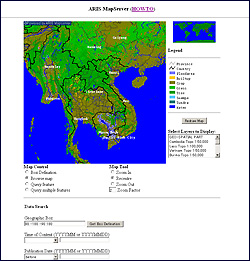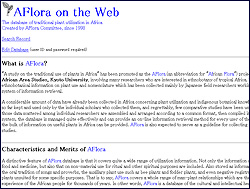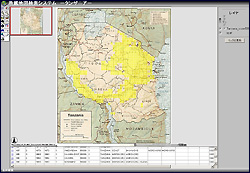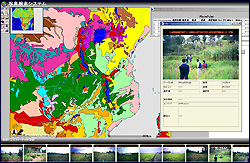| |
|
 |
Network Building Project |
 |

| The Network Section of the Area Info Division is undertaking this project with the goal of establishing a network for area studies. The project aims to lay the foundations for the various functions that the “Center for Integrated Area Studies” is expected to fulfill. |
|
|
| |
 |
 |
 |
 |
|
 ASCOM:http://ascom.asafas.kyoto-u.ac.jp/ ASCOM:http://ascom.asafas.kyoto-u.ac.jp/
 The Network Section is preparing for the launch of the “AreaStudiesInformationCenter,” and has already set up groupware to support information exchange, which is to become the core of the Center’s activities. (Groupware is an application that enables members of a network to share information through a website.) The name of the server is “ASCOM,” which is an abbreviation of Area Studies COMmunity. The Network Section is preparing for the launch of the “AreaStudiesInformationCenter,” and has already set up groupware to support information exchange, which is to become the core of the Center’s activities. (Groupware is an application that enables members of a network to share information through a website.) The name of the server is “ASCOM,” which is an abbreviation of Area Studies COMmunity.
ASCOM can fulfill a variety of functions, some of the important ones of which are as follows:
- Electronic bulletin board/conferencing systems: These enable individual groups to hold on-line conferences and accumulate information.
- File management: For the accumulation and shared use of MS Word document files, image files, etc.
- Schedule management: Display of schedules for individuals and groups.
- Reservations for the use of facilities: Management of on-line reservations for the use of facilities such as seminar rooms and conference rooms.
- Web mail system: Enables network members to read and write e-mail from wherever a web browser is accessible.
- To-do list: Used for managing things to be done, by order of priority.
- Search function: The ASCOM groupware application allows multi-database searches of accumulated data.
(You can find English-language manuals at the following URL: http://cybozu.com/supportcenter/s360v2/manuals/)
In order to use the ASCOM groupware, users need to belong to one or more “groups.” Since the data shared by a certain group are not accessible to people outside of the group, it is possible to operate one system for several study groups, or for several different purposes.
ASCOM uses an English version of “Cybozu,” which has a solid reputation as a groupware application. We introduced the English version in consideration of the fact that research activities for the 21st Century COE program involve frequent use of the groupware outside Japan and by non-Japanese-speaking users, and that the Japanese version cannot be run on English-language operating systems. (It should be pointed out, however, that Japanese-speaking users can switch to Japanese display, and write in Japanese without any problems).
Since its introduction, this system has begun to be used for the exchange of administrative information within the division, notifications on classes and lectures, and the sharing of image files among students and faculty members in research projects. It is expected that the system will grow further building on these uses, and prove instrumental in facilitating international collaboration on research activities. |
|
|
|
 |
 |
 |
|
 Human Ecology Files Human Ecology Files
A large collection of files on human ecology (consisting of 5,600 files) that were gathered and accumulated by the East-West Center in Hawaii were transferred to the Center for Southeast Asian Studies (CSEAS) of Kyoto University in 2000, partly through the good offices of Professor Terry Rambo, a former professor of CSEAS and a professor at the East-West Center at the time. The files include written materials on human ecology throughout the world, drawn from sources that had not been conserved and kept in proper order, such as abstracts of papers presented at academic conferences, university bulletins, various reports, and magazine clippings. These items were stored in a searchable state, with each item placed in a folder, and with its bibliographical data, such as the author’s name, year of publication, and keywords, entered on an index card for reference purpose. Subsequently, an Agro-forestry file (1,600 files) and Watershed file (1,200 files) were added, meaning that a total of 8,400 files were stored in the CSEAS’s map storage room. These are collectively called the Human Ecology Files (HEFs).
Following the transfer of the HEFs, the CSEAS began to enter the bibliographical information on the HEFs into a database beginning in 2001, with the aim of making the information accessible on-line, not simply by means of the index cards as in the past. Since then, with assistance from various subsidies, including the expanded budget that became available with the launching of the 21st Century COE project, efforts have been made to sort out the files, feed the bibliographical data on the files into computers, develop a retrieval system, and improve the environment for browsing the files. The digitalized bibliographical data on the HEFs are scheduled to be made accessible on-line during FY2005. |
 |
|
 |
 |
 |
 |
|
 Southeast Asian Topographic Map Database:http://aris.cseas.kyoto-u.ac.jp/mapserver/ Southeast Asian Topographic Map Database:http://aris.cseas.kyoto-u.ac.jp/mapserver/
 The Southeast Asian Topographic Map Database is a large collection of maps covering continental Southeast Asia, and including very rare topographic charts, such as ones of Myanmar made during British colonial rule. The Southeast Asian Topographic Map Database is a large collection of maps covering continental Southeast Asia, and including very rare topographic charts, such as ones of Myanmar made during British colonial rule.
In building a database, “metadata” describing the content, quality, condition, and other characteristics of the data in the database are indispensable. This database makes use of the Dublin Core Metadata Template, a standard metadata encoding system. The database itself is constructed using open-source software such as PostgreSQL/PostGIS and Minnesota Mapserver
Researchers affiliated with universities or doing academic research can make use of this database free of charge. For detailed explanations about how to use the database, please refer to: http://130.54.102.244/mapserver/help.html |
 |
|
 |
 |
 |
 |
|
 AFLORA:http://130.54.103.36/aflora.nsf AFLORA:http://130.54.103.36/aflora.nsf
 The African Flora (Aflora) Database has been compiled on the basis of data that have been collected over the years on the traditional use of plants in Africa, and is freely accessible on-line. Given the fact that the basic application supporting the database (Lotus Notes) has grown outdated, work is now underway to reconstruct the database so that it can be operated in a new open-source environment (Postgre SQL + PHP). The African Flora (Aflora) Database has been compiled on the basis of data that have been collected over the years on the traditional use of plants in Africa, and is freely accessible on-line. Given the fact that the basic application supporting the database (Lotus Notes) has grown outdated, work is now underway to reconstruct the database so that it can be operated in a new open-source environment (Postgre SQL + PHP).
|
 |
|
 |
 |
 |
 |
|
 Web Archiving Web Archiving
Since FY2004, work has been underway toautomatically crawl through web pages and collect and accumulate data which might otherwise be discarded. This operation is performed with the use of a dedicated Windows XP machine, on a closed basis (that is to say, without allowing outsiders access to the accumulated data, and with no copying of the data in principle). This operation is carried out with the idea that we should not allow publicly available information related to area studies to become inaccessible, or simply eliminated, when websites are updated, and therefore that something must be done before the loss of potentially precious pieces of information. The operation is performed periodically at the pace of once a week, using the free web robot “PageDown” (PD192), which is automatically run by Windows XP, concurrently with a simple batch-file for data sorting. Initially, the crawling was performed once a day, and in July 2004 the frequency was changed to once a week in consideration of the rates of updating of various sites, and the schedule has remained unchanged to date. The amount of data accumulated as of April 2005 takes up approximately 65.2 GB of the 230GB storage capacity of the hard disk (it has a total capacity of 460GB, but its actual capacity is 230GB due to mirroring).
In choosing the sites to be crawled, a survey was taken of the people involved in the 21st Century COE program, and all the websites cited except for those with functions found to be incompatible with the web robot were chosen. At present, a total of 13 websites, including the website of the 21st Century COE Program, are visited. With the present hardware, it seems that it will be possible to keep accumulating data for another three years or so. The system is designed in such a way that even if it runs out of capacity, it can continue accumulating data simply by replacing the hard disk. The system in its present form leaves some things to be desired, such as certain parts of the websites that are not crawled. We are eager to improve the system, to make it capable of collecting data for a longer span of time, and from larger number of sites. |
 |
|
 |
 |
 |
 |
|
 Area Studies Image Database Area Studies Image Database
 |
| Figure 1. Conceptual image of the database to be placed on the website |
This database, which is now under construction, is being built by collecting photographs, showing the reality of fieldwork, from faculty members and students dispatched for field studies as part of the 21st Century COE program. The photographs, which will be made accessible on-line accompanied by explanatory notes, are expected to help deepen understanding of Asia and Africa. A system will soon be installed on the website allowing photos from a certain location, along with explanations, to be displayed simply by clicking on a certain location on a map (See Figure 1). In the future, we are planning to upgrade the system into one that makes use of an Internet mapserver, enabling users to browse photographic images while viewing various background images of thematic maps such as vegetation and population density maps.
The system is still working on a trial basis, but the following prototypes have been released on the website: (1) maps in the possession of the Graduate School of Asian and African Area Studies (ClickableMap, Figure 2), and (2) photographs in the possession of ASAFAS (PhotoPoint_HTML, Figure 3). Please visit the URL (http://data.africa.kyoto-u.ac.jp/website/ *preparations are underway to make the website publicly accessible). The former system enables users to browse topographic maps in the possession of ASAFAS, by retrieving them from a map, and to view the required topographic information. So far, topographic maps from just three East African countries have been fed into the system, but work is continuing to incorporate maps of other areas. A Java viewer is necessary for displaying the topographic maps. The latter system is for browsing photographic images. The system manages a variety of map data (i.e., vegetation maps, topographic maps, national borders, and geographical location data on photographs, at present) as layered data in such a way that these can be searched either from the maps or from written information. Figure 3 shows a photograph that has been retrieved from a vegetation map of Africa.
 |
 |
| Figure 2. System for Browsing Maps in the Possession of ASAFAS |
Figure 3. System for Browsing Photographs in the Possession of ASAFAS |
|
 |
|
 |
 |
 |
 |
|
 The Kotmai Tra Sam Duang (Three Seals Law) Project:http://thaidtp.cseas.kyoto-u.ac.jp/ The Kotmai Tra Sam Duang (Three Seals Law) Project:http://thaidtp.cseas.kyoto-u.ac.jp/
Under this project, we are preparing to make the Thai-language Database of Kotmai Tra Sam Duang (Three Seals Law) accessible on-line by the end of May 2005. The oldest code of statute laws in Thailand, compiled in 1805 by King Rama I of the present Rattanakosin Dynasty, it encompasses all the laws and regulations concerning social and economic activities that were established and promulgated in the 455-year period from the era of the Ayutthaya dynasty in 1350 to 1805. The Center for Southeast Asian Studies (CSEAS), Kyoto University, published a five-volume Computer Concordance of The Law of Three Seals (with a total of 239,576 passages printed on 3,850 pages; published from Amarin Publications in Thailand) based on the five-volume Thammasat University edition of The Three Seals Law. Given, however, the fact that the concordance went out of print years ago, and has become hard to obtain, CSEAS, as a leading institution in the study of this code of laws, has been strongly urged by the international academic community to make the concordance accessible via the Internet. There are no similar databases in the world. This project aims to construct and maintain a digital archive, consisting of a database of the entire text of the code and a database of images of the original texts linked the text database, and to make the archive accessible on-line. The digital archive will be multilingual in the true sense of the word, as it will be possible to search the text database in Thai and have the search results displayed in Thai, with bibliographical notes to the search results shown in Thai, English, and Japanese.
This historical material is considered invaluable for a wide range of studies, including on the relationship between political power and Buddhism, and social and economic activities in Thailand from the medieval to early modern periods, studies on the influences of the ancient Indian codes of laws (from the 2nd century B.C. to the 2nd century A.D.) on the Thai code, and studies on the diffusion of Hinduism and Buddhism. Another feature of the code is that it contains materials written in Sanskrit and Pali, which are materials of primary importance for historical linguistic studies. The project to construct the database of the Three Seals Law, and to make it accessible on-line, therefore, is of great academic importance as it will facilitate not only studies in the social and economic history of Thailand but also studies in the histories of the Orient and Southeast Asia. |
 |
|
 |
 |
 |
 |
|
 Video Streaming Video Streaming
The 21st Century COE Program attaches great importance to digitizing various pieces of information related to area studies that have been accumulated, and making them accessible internationally. With regard to the processing and dissemination of image data, significant efforts have been made to digitize slides, and to collect and preserve photographs submitted by researchers dispatched abroad for field surveys. In addition to these efforts, it has been decided recently that we will begin constructing a system for storing clips taken by video camera, and disseminating them through the Internet in the form of streamed video. Work is already underway to purchase software for the dissemination of video, and to start accumulating video files. The dissemination of streamed video from the website of the 21st Century COE Program is scheduled to be commenced during the current fiscal year. |
 |
|
 |
 |
 |
 |
|
 Digitalization of Photographic Images in the Form of PhotoCDs Digitalization of Photographic Images in the Form of PhotoCDs
In the past, slides with high academic value have been stored by individual researchers, but work is now in progress to preserve them in the form of PhotoCDs. Already, several thousand slides have been digitized into PhotoCDs. |
 |
|
 |
 |
 |
 |
|
| |
|

